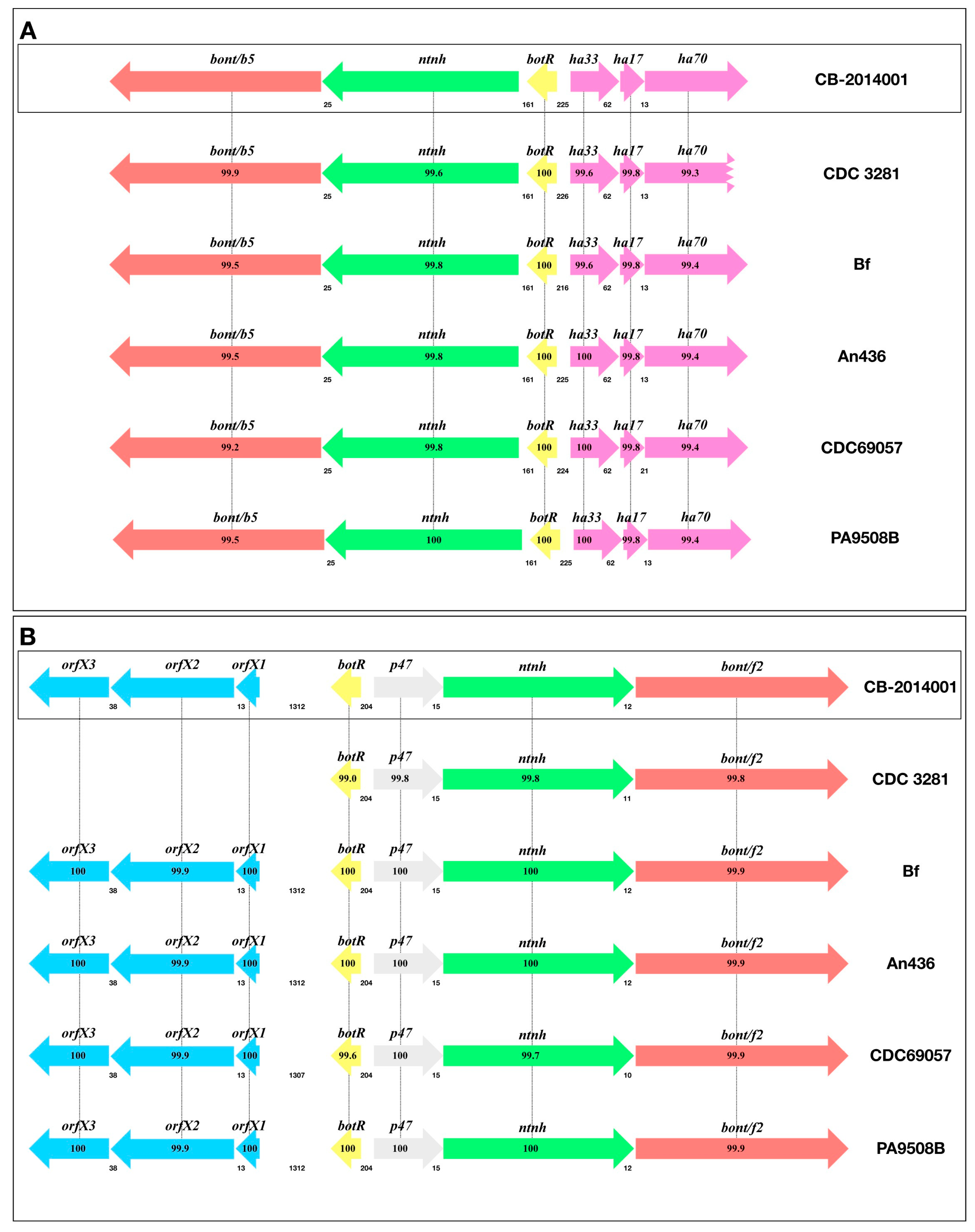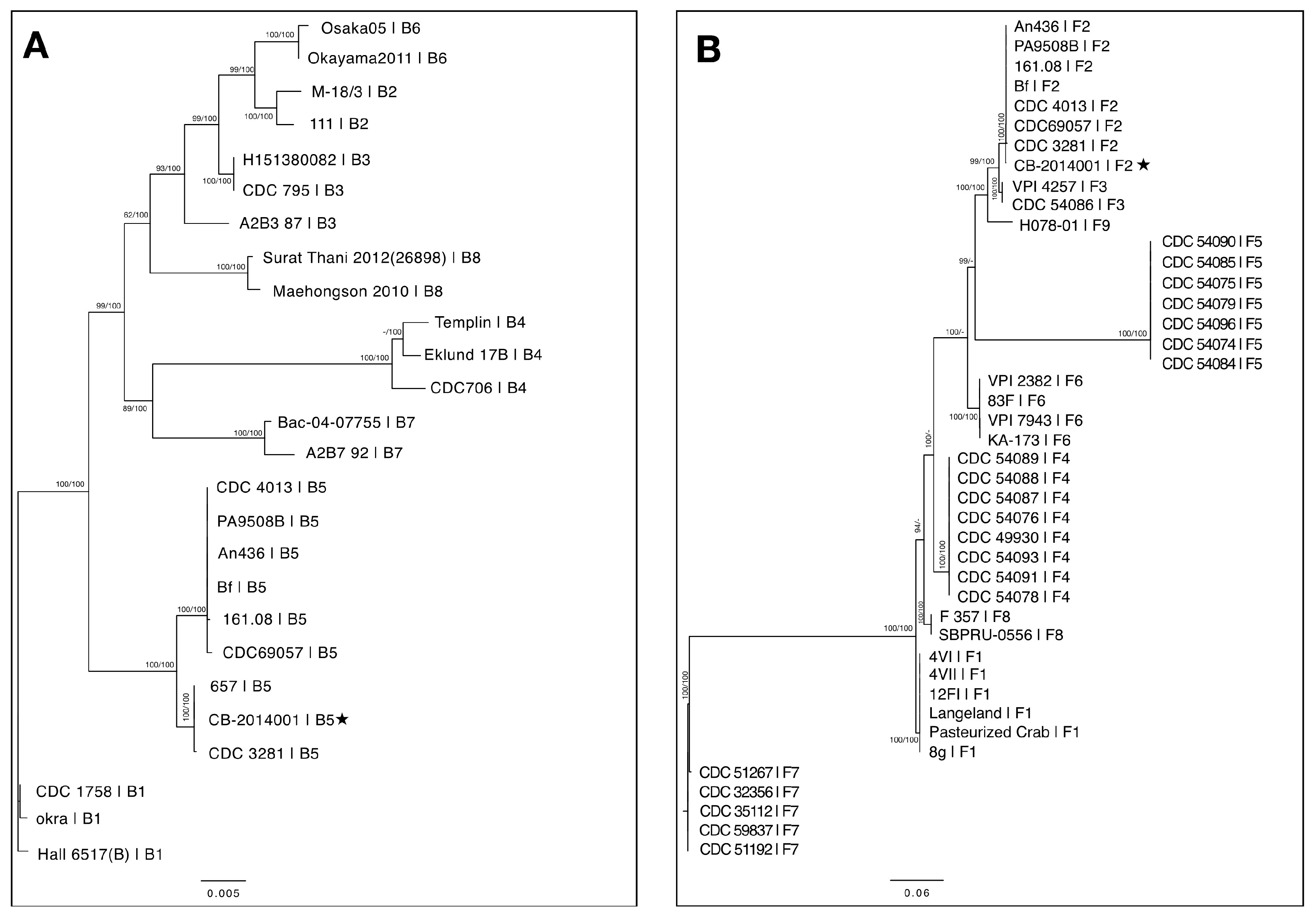Dual-Toxin-Producing Clostridium botulinum Strain Isolated from a Foodborne Botulism Case in Korea: Genomic and Functional Insights
Abstract
1. Introduction
2. Results
2.1. Genomic Analysis of CB-2014001
2.2. Recultivation and Mouse Bioassay of CB-2014001
2.3. Temperature-Dependent Expression of BoNT/B and BoNT/F
3. Discussion
4. Conclusions
5. Materials and Methods
5.1. Bacterial Strain
5.2. Mouse Bioassay
5.3. Genomic DNA Extraction
5.4. Genomic Analysis
Supplementary Materials
Author Contributions
Funding
Institutional Review Board Statement
Informed Consent Statement
Data Availability Statement
Conflicts of Interest
References
- Peck, M.W.; Smith, T.J.; Anniballi, F.; Austin, J.W.; Bano, L.; Bradshaw, M.; Cuervo, P.; Cheng, L.W.; Derman, Y.; Dorner, B.G.; et al. Historical perspectives and guidelines for botulinum neurotoxin subtype nomenclature. Toxins 2017, 9, 38. [Google Scholar] [CrossRef] [PubMed]
- Centers for Disease Control and Prevention (CDC). National Botulism Surveillance. Available online: https://www.cdc.gov/botulism/php/national-botulism-surveillance/?CDC_AAref_Val=https://www.cdc.gov/botulism/surveillance.html (accessed on 6 March 2025).
- Korea Disease Control and Prevention Agency (KDCA). Infectious Disease Portal. Available online: https://www.kdca.go.kr/npt/ (accessed on 6 March 2025).
- Jeon, J.H.; Choi, C.H.; Kim, J.H.; Hyun, J.; Choi, E.S.; Choi, S.Y.; Shin, Y.W.; Pyo, S.W.; Kim, D.W.; Kang, B.H.; et al. Genetic characterization of Clostridium botulinum isolated from the first case of infant Botulism in Korea. Ann. Lab. Med. 2021, 41, 489–492. [Google Scholar] [CrossRef]
- Lúquez, C.; Raphael, B.H.; Maslanka, S.E. Neurotoxin gene clusters in Clostridium botulinum type Ab strains. Appl. Environ. Microbiol. 2009, 75, 6094–6101. [Google Scholar] [CrossRef] [PubMed]
- Marshall, K.M.; Bradshaw, M.; Pellett, S.; Johnson, E.A. Plasmid encoded neurotoxin genes in Clostridium botulinum serotype A subtypes. Biochem. Biophys. Res. Commun. 2007, 361, 49–54. [Google Scholar] [CrossRef]
- Hatheway, C.L.; McCroskey, L.M. Examination of feces and serum for diagnosis of infant botulism in 336 patients. J. Clin. Microbiol. 1987, 25, 2334–2338. [Google Scholar] [CrossRef] [PubMed]
- Giménez, D.F.; Ciccarelli, A.S. New strains of Clostridium botulinum subtype Af. Zentralbl Bakteriol. Orig. A 1978, 240, 215–220. [Google Scholar]
- Dover, N.; Barash, J.R.; Hill, K.K.; Davenport, K.W.; Teshima, H.; Xie, G.; Arnon, S.S. Clostridium botulinum strain Af84 contains three neurotoxin gene clusters: Bont/A2, bont/F4 and bont/F5. PLoS ONE 2013, 8, e61205. [Google Scholar] [CrossRef]
- Sobel, J.; Tucker, N.; Sulka, A.; McLaughlin, J.; Maslanka, S. Foodborne botulism in the United States, 1990–2000. Emerg. Infect. Dis. 2004, 10, 1606–1611. [Google Scholar] [CrossRef]
- Edmunds, S.; Vugia, D.J.; Rosen, H.E.; Wong, K.K.; Dykes, J.K.; Griffin, P.M.; Chatham-Stephens, K. Inadequate refrigeration of some commercial foods is a continued cause of foodborne botulism in the United States, 1994–2021. Foodborne Pathog. Dis. 2022, 19, 417–422. [Google Scholar] [CrossRef]
- Vanhomwegen, J.; Berthet, N.; Mazuet, C.; Guigon, G.; Vallaeys, T.; Stamboliyska, R.; Dubois, P.; Kennedy, G.C.; Cole, S.T.; Caro, V.; et al. Application of high-density DNA resequencing microarray for detection and characterization of botulinum neurotoxin-producing clostridia. PLoS ONE 2013, 8, e67510. [Google Scholar] [CrossRef]
- Barash, J.R.; Arnon, S.S. Dual toxin-producing strain of Clostridium botulinum type Bf isolated from a California patient with infant botulism. J. Clin. Microbiol. 2004, 42, 1713–1715. [Google Scholar] [CrossRef]
- Altschul, S.F.; Gish, W.; Miller, W.; Myers, E.W.; Lipman, D.J. Basic local alignment search tool. J. Mol. Biol. 1990, 215, 403–410. [Google Scholar] [CrossRef] [PubMed]
- Meier-Kolthoff, J.P.; Carbasse, J.S.; Peinado-Olarte, R.L.; Göker, M. TYGS and LPSN: A database tandem for fast and reliable genome-based classification and nomenclature of prokaryotes. Nucleic Acids Res. 2022, 50, D801–D807. [Google Scholar] [CrossRef] [PubMed]
- Davies, J.R. BoNTbase: A botulinum neurotoxin Database. Toxicon 2018, 156, S20. [Google Scholar] [CrossRef]
- Hill, K.K.; Smith, T.J. Genetic diversity within Clostridium botulinum serotypes, botulinum neurotoxin gene clusters and toxin subtypes. Curr. Top. Microbiol. Immunol. 2013, 364, 1–20. [Google Scholar] [CrossRef] [PubMed]
- Couesnon, A.; Raffestin, S.; Popoff, M.R. Expression of botulinum neurotoxins A and E, and associated non-toxin genes, during the transition phase and stability at high temperature: Analysis by quantitative reverse transcripsion-PCR. Microbiology 2006, 152, 759–770. [Google Scholar] [CrossRef]
- Smith, G.E.; Hinde, F.; Westmoreland, D.; Berry, P.R.; Gilbert, R.J. Infantile botulism. Arch. Dis. Child. 1989, 64, 871–872. [Google Scholar] [CrossRef]
- Panditrao, M.V.; Chung, C.H.; Khouri, J.M.; Barash, J.R.; Motter, R.N.; Dover, N.; Arnon, S.S. Dual-toxin (“Bivalent”) infant botulism in California, 1976-2020: Epidemiologic, Clinical, and Laboratory aspects. J. Pediatr. 2023, 253, 8–13. [Google Scholar] [CrossRef]
- Rasetti-Escargueil, C.; Popoff, M.R. Antibodies and vaccines against Botulinum toxins: Available measures and novel approaches. Toxins 2019, 11, 528. [Google Scholar] [CrossRef]
- Food and Drug Administration (FDA). BAT (Botulism Antitoxin Heptavalent (A, B, C, D, E, F, G)-(Equine). Available online: https://www.fda.gov/vaccines-blood-biologics/approved-blood-products/bat-botulism-antitoxin-heptavalent-b-c-d-e-f-g-equine (accessed on 3 June 2025).
- Lu, J.; Jiang, Y.; Guo, J.; Chen, L.; Liu, F.; Li, Z.; Liu, X.; Du, P.; Yu, Y.; Wang, R.; et al. A human bispecific antibody neutralizes botulinum neurotoxin serotype A. Sci. Rep. 2023, 13, 20806. [Google Scholar] [CrossRef]
- Raja, S.M.; Guptill, J.T.; Juel, V.C.; Walter, E.B.; Cohen-Wolkowiez, M.; Hill, H.; Sendra, E.; Hauser, B.; Jackson, P.; Tomic, M.; et al. First-in-Human clinical trial to assess the safety, tolerability and pharmacokinetics of single doses of NTM-1633, a novel mixture of monoclonal antibodies against botulinum toxin E. Randomized Control. Trial 2022, 66, e0173221. [Google Scholar] [CrossRef] [PubMed]


| Condition | No. of Mice Alive/Tested | Toxin Type Detected |
|---|---|---|
| Untreated filtrate | 0/2 | - |
| Heat-treated filtrate | 2/2 | - |
| Filtrate + antitoxin B | 0/2 | - |
| Filtrate + antitoxin F | 0/2 | - |
| Filtrate + antitoxin B + F | 2/2 | B and F |
| Condition | No. of Mice Alive/Tested | Toxin Type Detected | ||
|---|---|---|---|---|
| 30 °C | 37 °C | 30 °C | 37 °C | |
| Untreated filtrate | 0/2 | 0/2 | - | - |
| Heat-treated filtrate | 2/2 | 2/2 | - | - |
| Filtrate + antitoxin B | 0/2 | 2/2 | - | B |
| Filtrate + antitoxin F | 2/2 | 0/2 | F | - |
Disclaimer/Publisher’s Note: The statements, opinions and data contained in all publications are solely those of the individual author(s) and contributor(s) and not of MDPI and/or the editor(s). MDPI and/or the editor(s) disclaim responsibility for any injury to people or property resulting from any ideas, methods, instructions or products referred to in the content. |
© 2025 by the authors. Licensee MDPI, Basel, Switzerland. This article is an open access article distributed under the terms and conditions of the Creative Commons Attribution (CC BY) license (https://creativecommons.org/licenses/by/4.0/).
Share and Cite
Choi, E.-S.; Choi, C.-H.; Jeon, J.-H.; Kim, S.-H.; Song, H.-J.; Yi, H.; Rhie, G.-e.; Chung, Y.-S. Dual-Toxin-Producing Clostridium botulinum Strain Isolated from a Foodborne Botulism Case in Korea: Genomic and Functional Insights. Toxins 2025, 17, 299. https://doi.org/10.3390/toxins17060299
Choi E-S, Choi C-H, Jeon J-H, Kim S-H, Song H-J, Yi H, Rhie G-e, Chung Y-S. Dual-Toxin-Producing Clostridium botulinum Strain Isolated from a Foodborne Botulism Case in Korea: Genomic and Functional Insights. Toxins. 2025; 17(6):299. https://doi.org/10.3390/toxins17060299
Chicago/Turabian StyleChoi, Eun-Sun, Chi-Hwan Choi, Jun-Ho Jeon, So-Hyeon Kim, Hyun-Ju Song, Hwajung Yi, Gi-eun Rhie, and Yoon-Seok Chung. 2025. "Dual-Toxin-Producing Clostridium botulinum Strain Isolated from a Foodborne Botulism Case in Korea: Genomic and Functional Insights" Toxins 17, no. 6: 299. https://doi.org/10.3390/toxins17060299
APA StyleChoi, E.-S., Choi, C.-H., Jeon, J.-H., Kim, S.-H., Song, H.-J., Yi, H., Rhie, G.-e., & Chung, Y.-S. (2025). Dual-Toxin-Producing Clostridium botulinum Strain Isolated from a Foodborne Botulism Case in Korea: Genomic and Functional Insights. Toxins, 17(6), 299. https://doi.org/10.3390/toxins17060299







